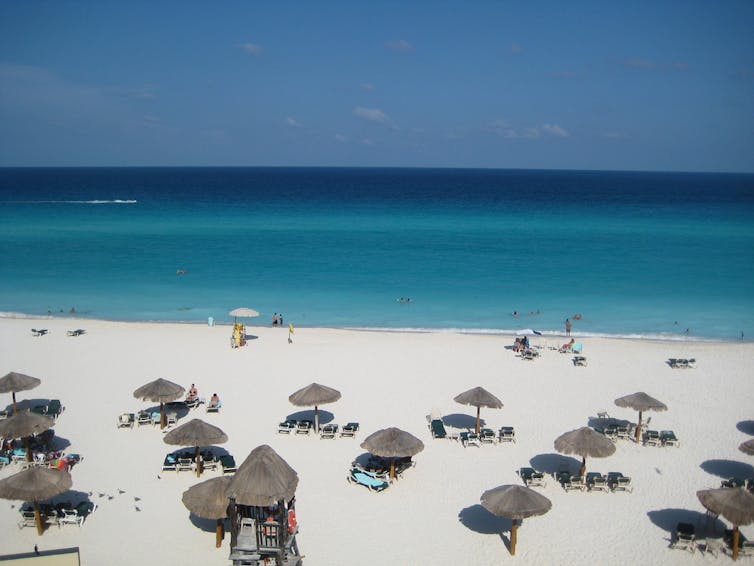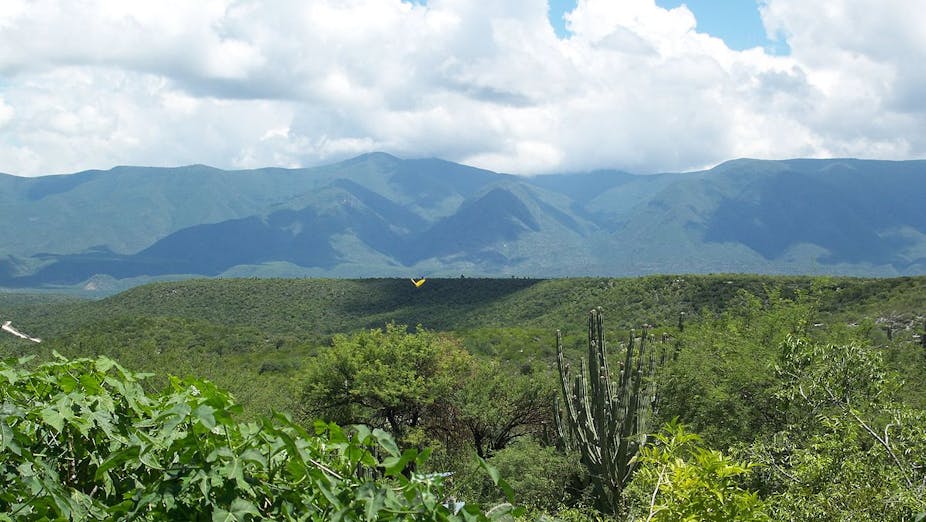At the UN’s Biodiversity Conference in Cancún (COP13) in early December 2016, Mexican President Enrique Peña Nieto announced that his government was creating four new nature reserves. This adds 181 protected natural environments – a total of 91 million hectares (70 million at sea and 21 million on land) – to Mexico’s existing 25 million hectares of reserves and biospheres.
Many greeted the announcement with enthusiasm. Protected natural areas are one of the most important and effective tools for safeguarding biodiversity and preventing habitat loss.
When done correctly, they also serve as a model for how humanity can live in harmony with nature, rather than destroying it. But Mexico faces many challenges to effectively implement its plan. Complicating factors in the newly protected areas include mass tourism, organised crime, current indigenous inhabitants and general profiteering.
Man versus nature
The Mexican Caribbean Biosphere, slated to include 100% of the Mesoamerican Reef system, will protect the most important turtle beaches in Quintana Roo state, on the Yucatan Peninsula, and prohibit oil exploration in Mexico’s Caribbean Sea.
That’s all good news. But because the reserve covers Cancun, Playa del Carmen and Tulum, the law also acknowledges that tourism is still a priority in the areas.
Environmental protection is good for tourism too. But Mexico has generally managed this industry badly, leading to negative environmental impacts around Cancun.
New regulations requiring that all new developments be sustainably built should help avoid causing more irreparable damage to the fragile and very vulnerable coastal environment, but it’s not a panacea.

Another new marine reserve, the Biosphere of the Mexican Pacific Deep, encompasses almost the entire Mexican Pacific shore. It aims to protect the rich biodiversity present in, marine areas off the coast of Nayarit, Jalisco, Colima, Michoacán, Guerrero, Oaxaca and Chiapas states. That includes 42 species of stony corals, 1,006 species of algae, and more than 920 endemic molluscs.
Guaranteeing their reproductive habitat will be complicated, and involve controlling activity related to the beaches and fishing communities in seven states. Five of the seven are among Mexico’s poorest, while Guerrero, Michoacán, Colima and Jalisco are the most violent.

Creating this huge protected natural area could provide an opportunity for much-needed development in this impoverished region. Under current regulations, nature reserves are subject to zoning that outlines permitted land uses for each area.
In core zones, access is restricted and existing inhabitants must be relocated. But in certain designated areas, business activities such as tourism, mining, forestry and agriculture can still occur.
In theory, displaced people can work in these newly created industries, particularly tourism, entering the “green economy”. But in practice, these schemes often simply force locals off their land while limiting traditional economic activities, such as fishing, and compel people to migrate.
The new marine-based Biosphere Reserve Pacific Islands of the Baja California Peninsula, which includes 21 islands and 97 islets, faces similar risks. In recent years, both Baja California and Baja California Sur, home to Tijuana and Los Cabos, have seen a rise in conflicts between environmentalists, fishermen and tourism providers.
The last newly designated nature reserve is the Sierra de Tamaulipas Biosphere Reserve, a mountainous area that’s home to pumas and jaguars, among other wild animals. It also supplies water to several sub-basins. Justification for its federal protection goes back all the way to 2006.
Today, the area has a strong cartel presence, which makes actually restricting human activity in core zones difficult. Locals are bribed and face threats of violence to allow criminal groups to “to plant what they need to plant”. The presence of cartels also makes it impractical for unarmed environmental inspectors to enforce laws and impossible for scientists and environmentalists to do research in the new biosphere.

Given all of this, Peña Nieto’s effort is laudable but perhaps badly planned. The vast new expanse involves numerous states, municipalities, and villages with complex economic, cultural, social, and religious ethnic realities. All of this must fully considered for environmental protection to be effective.
Conflicts with original inhabitants
Mexico’s century-long track record of conservation efforts is mixed. The government has, for example, often failed to consult local inhabitants before designating their land as a nature reserve. A 2007 study found that many residents of Mexico’s 158 protected areas had no idea their homes were in a nature reserve.
Mexico also has the very bad habit of allowing privatisation of its “protected” zones. Entrepreneurs, including billionaire telecoms mogul Carlos Slim,, frequently purchase land and receive concessions to launch extractive activities.
Journalist Nancy Flores’ Project 2030 shows that at least 23 Mexican wildlife conservation zones (2.5 million hectares of “protected” land) have been partially privatised since 2010.
Though regulations should limit environmentally damaging activities, such as mining and logging, in practice the permit system is easily corrupted, and municipal authorities have limited capacity to monitor and control these sectors.
Ecologist Elisa Armendáriz-Villegas recently overlaid a map of 24,715 mining concessions granted through 2010 with a map of Mexico’s protected natural areas. She found 1,609 mines located in nature reserves, and that a third of all 63 federal protected natural areas were being actively mined.
Journalist Elva Mendoza’s 2012 report for the investigative journalism site Contralínea exposed similar misuse of government lands.
Failing constant monitoring by local populations, much of Mexico’s growing expanse of “protected” land will fall pray to privateering, becoming disputed, and often dangerous, territories.

It is perhaps unsurprising, then, that a 2008 study found that of 69 large government-protected natural areas established prior to 1997, 54% were barely effective in protecting vegetation, 23% were somewhat effective and 23% were ineffective.
Indeed, the original inhabitants of the country’s jungles and beaches may be better guardians of biodiversity than the Mexican government.
Around 70% to 80% of forests and jungles in Mexico are socially owned; they are shared land overseen by various communities. Research published in 2011 shows that these communities often implement successful local conservation efforts. Comparing a group of 67 protected areas in Mexico to ejidos (communally owned lands) over 20 years, the paper’s authors found that communities had preserved 95% of the ejidos’ original forest cover while protected areas had maintained 98.8%.

Creating nature preserves is thus necessary but not sufficient for saving Mexico’s environment. If a primary objective of nature preserves is to serve as a model for how human populations may live in harmony with natural resources, then Mexico has a long way to go.
Without comprehensive policies to govern not just natural areas but also the people who live there and market forces that seek to exploit them, Peña Nieto’s COP13 declaration could turn out to be little more than a political gesture.

